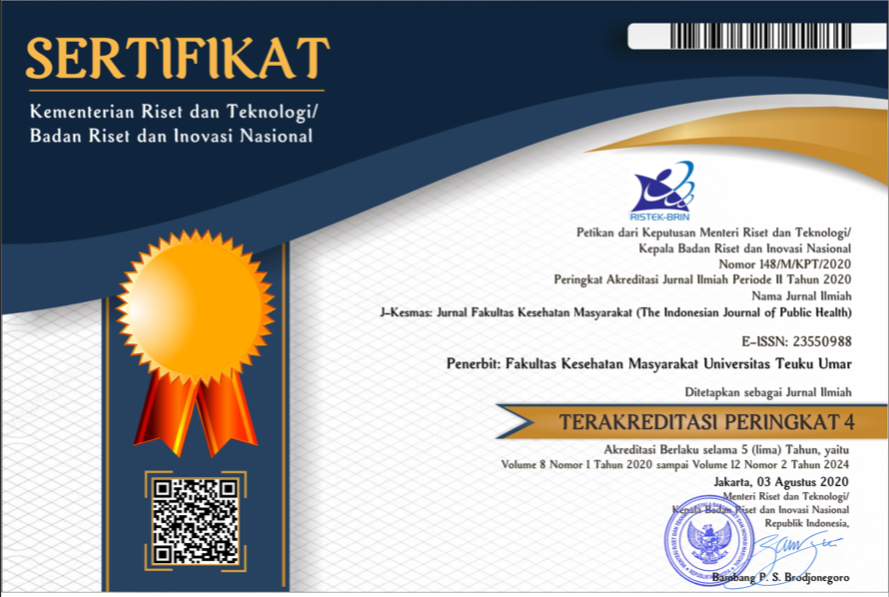The Risk Factor of Leprosy and The Care Process of Patient with Leprosy in Mahengetang Island of Sangihe: Qualitative Study
Abstract
Leprosy is a chronic disease caused by Mycobacterium Leprae and can cause disability. Leprosy is a contagious disease from a medical perspective and extends social, economic, cultural, and social resilience issues. Mahengetang Island is one of the small islands in the Tatoareng District, Sangihe Islands Regency, with the highest leprosy cases in North Sulawesi Province. The research objective was to determine the risk factors for Leprosy and Care of leprosy patients in Mahengetang Tatoareng Island, Sangihe. The research method is a qualitative design with 13 informants who were interviewed. The participants are leprosy patients who undergo treatment and leprosy treatment which health workers supervise on Mahengetang Island. The research has been on for three months, from July to October 2020. The result showed that the risk factors for Leprosy were white spots (P1, P3, P5, P6), tasteless and cramps (P1, P2, P5, P10), thickened blackish skin (P2, P3, P4, P10, P12), itching and redness all over the body (P8). The result of research about leprosy patients are showed that one Participant took medication for six months (P1), seven participants took medication for one year, and five participants took the drug once. The conclusion is that the risk factors for Leprosy are white patches on the skin, tasteless and cramps, thickened black skin, itching, and redness all over the body. The care of Leprosy patients showed that all participants took Rifampicin with different periods depending on leprosy classification.
Keywords
Full Text:
PDFReferences
Astutik, E., Kiptiyah,N,M. (2016). Factors related to the Self-Care Behavior of Ex-LeLepers in the Technical Implementation Unit for Social Rehabilitation of Ex- Persons with Leprosy in Nganget Tuban, East Java.Indonesian Journal of health Epidemiology Vol. 1 No. 1
Cin, J. (2000). Control of Comunicable Desease Manual edisi 17, American Public Health Association, Wasington
Data Health Office (2020). Data from the Sangihe Islands District Health Office
Health Profile of Sangihe Islands District.2017.http://www. Kemkes.go.id accessed 28 Oct 2020
Health Office (2020). Profile of the Health Office in 2018
Herawati, C. (2019). Self care as a risk factor for disability in people with leprosy. Indonesia Public Health Journal Volume 14 number 1 accessed on 28 Oct 2020
Husein, S,H., Muhannad,R. (2017). Factors related to the incidence of disability in eprosy patients in the working area of the Kalumata health center, South Ternate City. Journal of Health Research Vol. 6 No. 2 https://ejournal.poltekkes.smg.ac.id lois/index.php/irk
Leprosy Control program.(2020). Directorate General of Disease Control and Environmental health. Jakarta. https://www. Joglabang.com.Retrieved February 2019
Ministerial RI health.(2011). Ministrerial Decree RI health. About the Guidelines Preparation of Health Human Resouces Planning at Provincial., District and Hospital Levels (2012). National Guidelines
Ministerial RI health.(2012). National Guidelines Leprosy Control program. Jakarta: Directorate general of Disease Control and Enviromental Health.https://www/joglabang.com. Retrieved February 19, 2020
Ministerial RI health.(2016). National Guidelines Leprosy Control Program. Jakarta
Ministerial RI Health.(2018). Indonesia health profile 2015 sat data and informes ditjenP2P (kemenkes) https://www.kemenkeu.go.id. February 27,2020 Accessed
Ministerial RI Health.(2019). Ministerial Regulation Health oh the Republic of Indonesia Number 11 of 2019. Regarding the Prevention of leprosy.https:www.kemenkes.go.id Retrieved 27 February 2020
National Institute of Allergy and Infectious Disease.leprosy (Internet). U.S: Department of Health and Human Services: 2011 (cited 2011, Desember). Available from http://www.niaid.nih.gov/topics/leprosy/understanding/pages/whatis.aspx
Moh RI (2012). National Guidebook for the Eradication of leprosy. Printed XVIII. Directorate general of Disease Control and Environmental Health
Siregar, T.,Ratnawati,D. (2018). Family experiences of caring for people with leprosy in facing Community Stigma in Limo Village,Depok, West Java. Indonesian Nursing Scientific Journal Vol 1 No. 2 http://www.journal.umt.ac.id/index.php.jik
Waworuntu. (2019). Chemoprophylaxis as Leprosy Post Exposure Prophylaxis Able to Reduce New Cases of leprosy.P2P. RI Ministry of helath, Directorate general Disease Control Prevention. Retrieved 28 March 2020
Word Health Organization. (2010). Infodatin. Center for Data and Information of the Ministry of health of the Republic of Indonesia
Word Health Organization.(2016). Leprosy Fact Sheet.www.who.int,Leprosy. Accessed on 27 February 2020 WHO,1982/Depkes R.I.1988. Classification of leprosy according to popeibacillary and multibacillary types
DOI: https://doi.org/10.35308/j-kesmas.v8i2.3409
Refbacks
- There are currently no refbacks.
Managed by Fakultas Kesehatan Masyarakat
Published by Universitas Teuku Umar
Website: http://jurnal.utu.ac.id/jkesmas
Email: jkemas@utu.ac.id 
This work is licensed under a Creative Commons Attribution-ShareAlike 4.0 International License.







.jpg)


